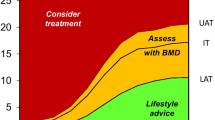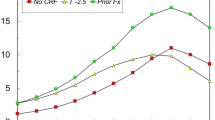Abstract
Introduction
With the development of country-specific FRAX® tools to estimate fracture probability, guidance is required on the fracture probability at which treatment can be recommended.
Objectives
The aim of the present study was to determine FRAX-based intervention thresholds in men and women from Turkey and determine their population impact.
Patients and methods
Intervention thresholds for treatment and assessment thresholds for measuring BMD were devised using the strategy adopted by the National Osteoporosis Guideline Group of the UK but applied to the fracture probabilities in Turkey. The number of men and women potentially eligible for treatment was determined from the distribution of FRAX-based probabilities of a major fracture (Turkish model, version 3.6) in a representative sample of 26,394 men and women aged 50 years or more.
Results
Intervention thresholds, set at the probability equivalents of a woman with a prior fragility fracture rose with age from 7.0 % at the age of 50 years to 31 % at the age of 90 years. Approximately 8.6 % of the female Turkish population aged 50 years or more had a prior fragility fracture and would be eligible for treatment. A further 13.6 % without a prior fracture would be eligible for treatment. In contrast, the number of men aged 50 years or more eligible for treatment was 3.1 %
Conclusions
FRAX-based guidelines can be developed and are expected to avoid unnecessary treatment of individuals at low fracture risk and direct treatments to those at high risk. The adoption of FRAX-based intervention thresholds will demand a reappraisal of the criteria for reimbursement of interventions and health economic assessment.


Similar content being viewed by others
References
Kanis JA on behalf of the World Health Organization Scientific Group (2008a) Assessment of osteoporosis at the primary health-care level. Technical Report. WHO Collaborating Centre, University of Sheffield, UK. http://www.shef.ac.uk/FRAX/index.htm. Accessed 3 Mar 2012
Kanis JA, Johnell O, Oden A, Dawson A, De Laet C, Jonsson B (2001) Ten year probabilities of osteoporotic fractures according to BMD and diagnostic thresholds. Osteoporos Int 12:989–995
Nguyen ND, Frost SA, Center JR, Eisman JA, Nguyen TV (2008) Development of prognostic nomograms for individualizing 5-year and 10-year fracture risks. Osteoporos Int 19:1431–1444
Hippisley-Cox J, Coupland C (2009) Predicting risk of osteoporotic fracture in men and women in England and Wales: prospective derivation and validation of QFractures Scores. Br Med J 339:b4229
Kanis JA, Hans D, Cooper C, Task Force of the FRAX Initiative (2011) Interpretation and use of FRAX in clinical practice. Osteoporos Int 22:395–411
Kanis JA, Johnell O, Oden A, Johansson H, McCloskey EV (2008) FRAX™ and the assessment of fracture probability in men and women from the UK. Osteoporos Int 19:385–397
Kanis JA, Oden A, Johnell O et al (2007) The use of clinical risk factors enhances the performance of BMD in the prediction of hip and osteoporotic fractures in men and women. Osteoporos Int 18:1033–1046
Kanis JA, Odén A, McCloskey EV, IOF Working Group on Epidemiology and Quality of Life et al (2012) A systematic review of hip fracture incidence and probability of fracture worldwide. Osteoporos Int. doi:10.1007s00198-012-1964-3
Elffors I, Allander E, Kanis JA et al (1994) The variable incidence of hip fracture in Southern Europe: the MEDOS Study. Osteoporosis Int 4:253–263
Tuzun S, Eskiyurt N, Akarirmak U, Saridogan M, Senocak M, Johansson H et al (2012) Incidence of hip fracture and prevalence of osteoporosis in Turkey: the FRACTURK study. Osteoporos Int 23:949–955
Compston J, Cooper A, Cooper C, on behalf of the National Osteoporosis Guideline Group (NOGG) et al (2009) Guidelines for the diagnosis and management of osteoporosis in postmenopausal women and men from the age of 50 years in the UK. Maturitas 62:105–108
Kanis JA, McCloskey EV, Johansson H, Strom O, Borgstrom F, Oden A, the National Osteoporosis Guideline Group (2008) Case finding for the management of osteoporosis with FRAX®—assessment and intervention thresholds for the UK. Osteoporos Int 19:1395–1408, Erratum 2009 Osteoporos Int 20, 499-502
Papaioannou A, Morin S, Cheung AM et al (2010) 2010 clinical practice guidelines for the diagnosis and management of osteoporosis in Canada: summary. CMAJ 182:1864–1873
Kanis JA, Delmas P, Burckhardt P, Cooper C, Torgerson D, on behalf of the European Foundation for Osteoporosis and Bone Disease (1997) Guidelines for diagnosis and management of osteoporosis. Osteoporos Int 7:390–406
Kanis JA, Burlet N, Cooper C, Delmas PD, Reginster JY, Borgstrom F, Rizzoli R, European Society for Clinical and Economic Aspects of Osteoporosis and Osteoarthritis (ESCEO) (2008) European guidance for the diagnosis and management of osteoporosis in postmenopausal women. Osteoporos Int 19:399–428
National Osteoporosis Foundation (2008) Clinician’s guide to prevention and treatment of osteoporosis. Washington, DC: National Osteoporosis Foundation. www.nof.org
European Community (1998) Report on osteoporosis in the European Community. 1998. EC, Strasbourg
Royal College of Physicians (1999) Osteoporosis: clinical guidelines for the prevention and treatment. Royal College of Physicians, London
Brixen K (2002) Consensus report on osteoporosis. Ugeskrift for Laeger, 2002, Suppl. 10.
Hellenic Foundation for Osteoporosis (2004) Kateufunthries gpammes gia th diagnwsh kai antimetwpisnh ths Osteopowshs sthn Ellada 2004 [Guidelines for diagnosis and management of osteoporosis in Greece 2004]. Athens
Collegio dei Reumatologi Ospedalieri (CROI), Società Italiana dell’Osteoporosi e delle Malattie del Metabolismo Minerale e Scheletrico (SIOMMMS), Società Italiana di Medicina Fisica e Riabilitativa (SIMFER), Società Italiana di Medicina Interna (SIMI), Società Italiana di Ortopedia e Traumatologia (SIOT), Società Italiana di Radiologia Medica (SIRM), Società Italiana di Reumatologia (SIR). (2006) Linee guida per la diagnosi, prevenzione e terapia dell’osteoporosi [Guidelines for the diagnosis, prevention and treatment of osteoporosis] Pavia, SINOSSI. EDIMES
Pols HA, Wittenberg J (2002) CBO guideline: osteoporosis. Nederlands Tijdschrift voor Geneeskunde 2002(146):1359–1363
Sociedad Española de Investigaciones Óseas Y Metabolismo Mineral (SEIOMM) (2003) Guía de Práctica: osteoporosis posmenopáusica [Practice guidelines:postmenopausal osteoporosis]. Revista Clinica Española, 203: 496–506. www.seiomm.org. Accessed 14 Nov 2006
SIGN (2003) Management of osteoporosis. Edinburgh, Scottish Intercollegiate Guidelines Network. www.sign.ac.uk. Accessed 14 Nov 2006
Kanis JA, Stevenson M, McCloskey EV, Davis S, Lloyd-Jones M (2007) Glucocorticoid-induced osteoporosis: a systematic review and cost-utility analysis. Health Technol Assess 11:1–256
Tosteson AN, Melton LJ 3rd, Dawson-Hughes B, National Osteoporosis Foundation Guide Committee et al (2008) Cost-effective osteoporosis treatment thresholds: the United States perspective. Osteoporos Int 19:437–447
Lekawasam S, Adachi JD, Agnusdei D F et al. for the Joint IOF-ECTS GIO Guidelines Working Group (2012) A framework for the development of guidelines for the management of glucocorticoid-induced osteoporosis. Osteoporos Int (in press)
Johansson H, Oden A, Johnell O et al (2004) Optimisation of BMD measurements to identify high risk groups for treatment—a test analysis. J Bone Miner Res 19:906–913
Turkey National Statistical Office (2009) TUIK-Turkey. http://report.tuik.gov.tr/reports/rwservlet?adnksdb2=&report=turkiye_yasgr.RDF&p_yil=2009&p_dil=1&desformat=html&ENVID=adnksdb2Env. Accessed 3 March 2012
Kobak S (2011) Demographic, clinical, and serological features of Turkish patients with rheumatoid arthritis: evaluation of 165 patients. Clin Rheumatol 30:843–847
United Nations (2010) Population Division of the Department of Economic and Social Affairs of the United Nations Secretariat, World Population Prospects: http://esa.un.org/unpd/wpp/unpp/panel_indicators.htm. Accessed Nov 2011
Kanis JA McCloskey EV, Johansson H, Cooper C, Rizzoli R, Reginster J-Y on behalf of the Scientific Advisory Board of the European Society for Clinical and Economic Aspects of Osteoporosis and Osteoarthritis (ESCEO) and the Committee of Scientific Advisors of the International Osteoporosis Foundation (IOF) (2012) European guidance for the diagnosis and management of osteoporosis in postmenopausal women. Osteoporos Int (in press)
Johansson H, Kanis JA, Oden A, Johnell O, McCloskey E (2009) BMD, clinical risk factors and their combination for hip fracture prevention. Osteoporos Int 20:1675–1682
Johansson H, Kanis JA, Oden A, Johnell O, Compston J, McCloskey EV (2012) A comparison of case finding strategies in the UK for the management of hip fractures. Osteoporos Int 23:907–915
Leslie WD, Lix LM, Majumdar SR et al (2011) High fracture probability with FRAX® usually indicates densitometric osteoporosis: implications for clinical practice. Osteoporos Int 23:391–397
Leslie WD, Lix LM, Morin S, Johnansson H, Odén A, McCloskey E, Kanis JA (2012) Fracture risk assessment without bone density measurement in routine clinical practice. Osteoporos Int 23:75–85
Kanis JA, McCloskey E, Johansson H, Oden A, Leslie WD (2012) FRAX® with and without BMD. Calcif Tiss Int 90:1–13
Kanis JA, Oden A, Johansson H, McCloskey E (2012) Pitfalls in the external validation of FRAX. Osteoporos Int 23:423–431
Kanis JA, Adams J, Borgström F, Cooper C, Jönsson B, Preedy D et al (2008) The cost-effectiveness of alendronate in the management of osteoporosis. Bone 42:4–15
Acknowledgments
This study was funded and promoted by the Turkish Osteoporosis Society. We are also grateful to Sanofi-Aventis, Roche, Novartis, MSD for their financial support. We would like to thank to Mr. Erkan Pekerkan and Mrs. Emine Pekerkan from Analyst Medical Marketing Research Ltd. for their great work and kind support during the study.
Conflicts of interest
None.
Author information
Authors and Affiliations
Consortia
Corresponding authors
Additional information
Turkish Osteoporosis Society: T. Arasil, F. Atalay, G. Dincer, B. Durmaz, O. El, Y. Kirazli, Y.G. Kutsal, S. Oncel, and O. Peker
Rights and permissions
About this article
Cite this article
Tuzun, S., Eskiyurt, N., Akarirmak, U. et al. The impact of a FRAX-based intervention threshold in Turkey: the FRAX-TURK study. Arch Osteoporos 7, 229–235 (2012). https://doi.org/10.1007/s11657-012-0101-4
Received:
Accepted:
Published:
Issue Date:
DOI: https://doi.org/10.1007/s11657-012-0101-4




